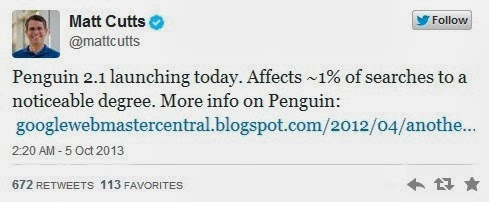The fifth confirmed release of Google’s “Penguin”
spam fighting algorithm is live. That makes it Penguin 5 by our count.
But since this Penguin update is using a slightly improved version of
Google’s “Penguin 2″ second-generation technology, Google itself is
calling it “Penguin 2.1.” Don’t worry. We’ll explain the numbering
nonsense below, as well as what this all means for publishers.
New Version Of Penguin Live Today
The head of Google’s web spam team, Matt Cutts, shared the news on Twitter, saying the latest release would impact about 1 percent of all searches:
The link
that Cutts points at, by the way, explains what Penguin was when it was
first launched. It doesn’t cover anything new or changed with the
latest release.
Previous Updates
Here are all the confirmed releases of Penguin to date:
- Penguin 1 on April 24, 2012 (impacting around 3.1% of queries)
- Penguin 2 on May 26, 2012 (impacting less than 0.1%)
- Penguin 3 on October 5, 2012 (impacting around 0.3% of queries)
- Penguin 4 (AKA Penguin 2.0) on May 22, 2013 (impacting 2.3% of queries)
- Penguin 5 (AKA Penguin 2.1) on Oct. 4, 2013 (impacting around 1% of queries)
Why Penguin 2.1 AND Penguin 5?
If us talking about Penguin 5 in reference to something Google is
calling Penguin 2.1 hurts your head, believe us, it hurts ours, too. But
you can pin that blame back on Google. Here’s why.
When Google started releasing its “Panda”
algorithm designed to fight low-quality content, it called the first
one simply “Panda.” So when the second came out, people referred to that
as “Panda 2.” When the third came out, people called that Panda 3 —
causing Google to say
that the third release, because it was relatively minor, really only
should be called Panda 2.1 — the “point” being used to indicate how much
a minor change it was.
Google eventually — and belatedly
— indicated that a Panda 3 release happened, causing the numbering to
move into Panda 3.0, Panda 3.1 and so on until there had been so many
“minor” updates that we having to resort to going further out in decimal
places to things like Panda 3.92.
That caused us here at Search Engine Land to decide it would be
easier all around if we just numbered any confirmed update sequentially,
in order of when they came. No matter how “big” or “small” an update
might be, we’d just give it the next number on the list: Penguin 1,
Penguin 2, Penguin 3 and so on.
Thanks For The Headache, Google
That worked out fine until Penguin 4, because Google typically didn’t
give these updates numbers itself. It just said there was an update,
and left it to us or others to attach a number to it.
But when Penguin 4 arrived, Google really wanted to stress that it
was using what it deemed to be a major, next-generation change in how
Penguin works. So, Google called it Penguin 2, despite all the
references to a Penguin 2 already being out there, despite the fact it
hadn’t really numbered many of these various updates before.
Today’s update, as can be seen above, has been dubbed Penguin 2.1 —
so supposedly, it’s a relatively minor change to the previous Penguin
filter that was being used. However, if it’s impacting around 1 percent
of queries as Google says, that means it is more significant than what
Google might have considered to be similar “minor” updates of Penguin
1.1 and Penguin 1.2.
What Is Penguin Again? And How Do I Deal With It?
For those new to the whole “Penguin” concept, Penguin is a part of
Google’s overall search algorithm that periodically looks for sites that
are deemed to be spamming Google’s search results but somehow still
ranking well. In particular, it goes after sites that may have purchased
paid links.
If you were hit by Penguin, you’ll likely know if you see a marked
drop in traffic that begins today or tomorrow. To recover, you’ll need
to do things like disavow bad links or manually have those removed.
Filing a reconsideration request doesn’t help, because Penguin is an
automated process. Until it sees that what it considers to be bad has
been removed, you don’t recover.
If you were previously hit by Penguin and have taken actions
hopefully meant to fix that, today and tomorrow are the days to watch.
If you see an improvement in traffic, that’s a sign that you’ve escaped
Penguin.
Here are previous articles with more on Penguin recovery and how it and other filters work as part of the ranking system
- The Google Dance Is Back
- Two Weeks In, Google Talks Penguin Update, Ways To Recover & Negative SEO
- How Google’s Disavow Links Tool Can Remove Penalties
- Why Asking StumbleUpon To Remove Your Links Is Dumb
- Google’s New Stance On Negative SEO: “Works Hard To Prevent” It
- Still Seeing Post-Penguin Web Spam In Google Results? Let Google Know
- Big Brand SEO & Penguin 2.0
- Demystifying Link Disavowals, Penalties & More
What About Hummingbird?
If you’re wondering about how Penguin fits into that new Google Hummingbird algorithm you may have heard about, think of Penguin as a part of Hummingbird, not as a replacement for it.
Hummingbird is like Google’s entire ranking engine, whereas Penguin
is like a small part of that engine, a filter that is removed and
periodically replaced with what Google considers to be a better filter
to help keep out bad stuff.
